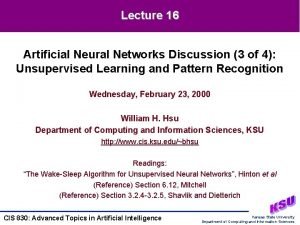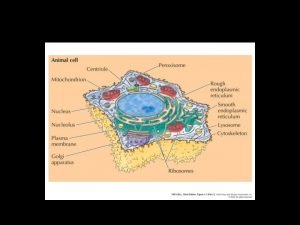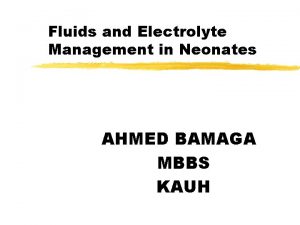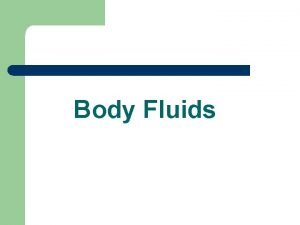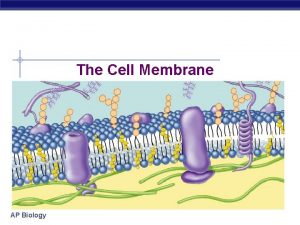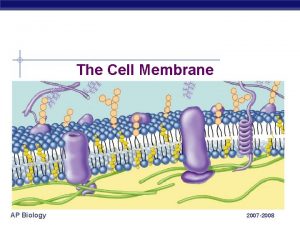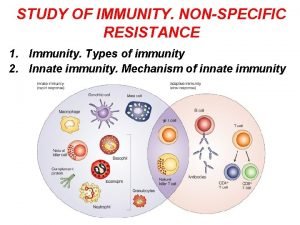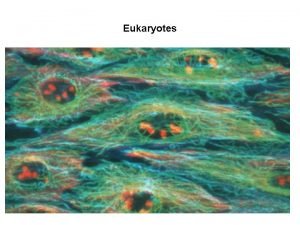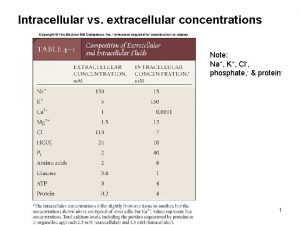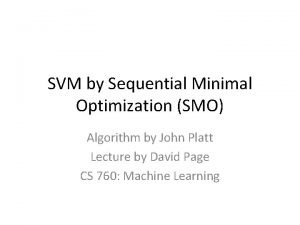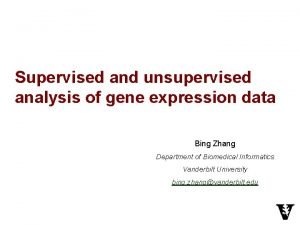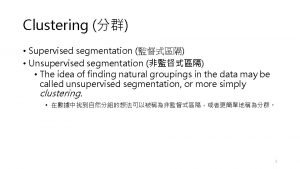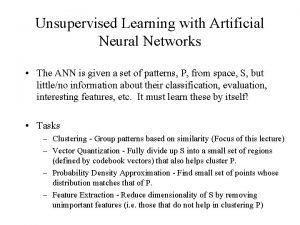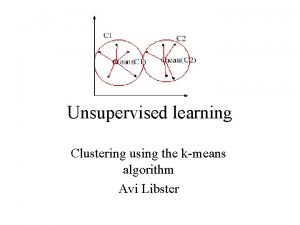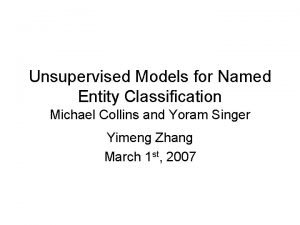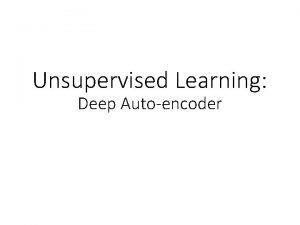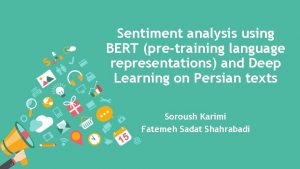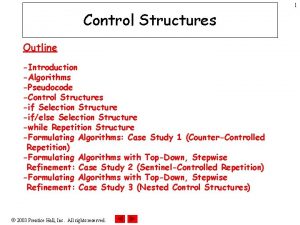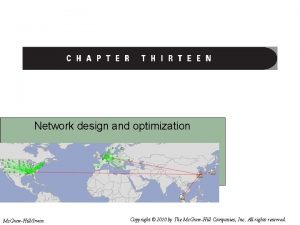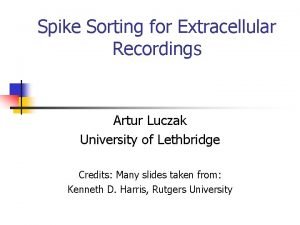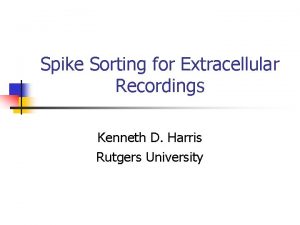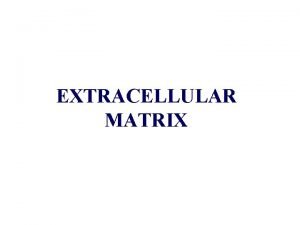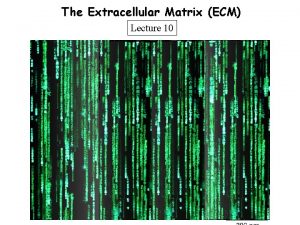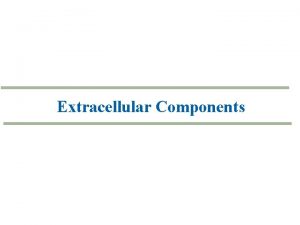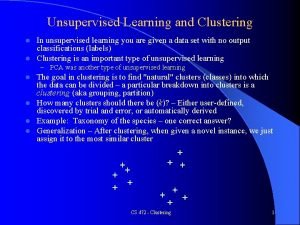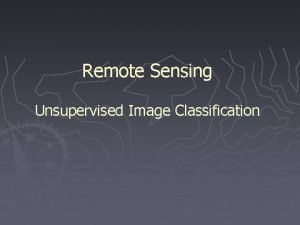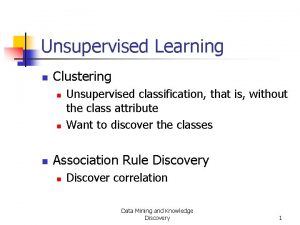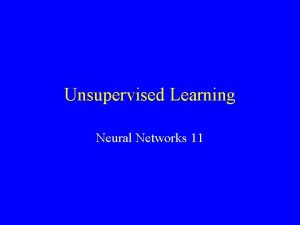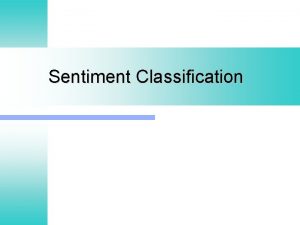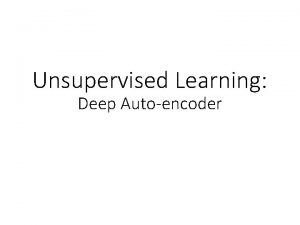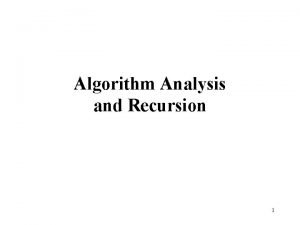Optimization of Extracellular Recordings Control Algorithm and Unsupervised

























































- Slides: 57

Optimization of Extracellular Recordings: Control Algorithm and Unsupervised Signal Processing Zoran Nenadic Division of Engineering and Applied Science California Institute of Technology Department of Biomedical Engineering University of California Irvine May 3, 2004 1

Why is it important to interface neurons and electrodes? 1) Neural-Prosthetic Systems Functional electrical stimulation for paralyzed patients Tremor suppression for Parkinson’s patients Medtronic, Activa System Communication link for ALS patients (Kennedy & Bakay, Neuro. Report, 1998) 2

Neuroprosthetics studies at Caltech For successful neural prosthesis it is critically important to record signals with high quality, signal yield and longevity. 3

2) Electrophysiological Recordings The technology prompted by the discovery of the microelectrode (Hubel, Science, 1957; Green, Nature, 1958) It enables us to observe the activity of a single neuron (population of neurons) in response to external stimuli and cognitive tasks. Electrophysiological Recordings Acute Chronic (electrodes in the brain for several hours) (arrays of electrodes implanted surgically) 4

Acute Recordings Basic Tool: microelectrode Key Challenge: isolate the activity of a single cell on a single electrode Single electrode Multi-electrode Limitations: time consuming, depends on the experience of the operator What can be done? unmanageable in multi-electrode environment Automate the process of cell isolation and tracking. 5

Chronic Recordings Key Challenge: record high quality signals from many neurons (for months/years). Make the probes autonomously track neurons, find new neurons, break through encapsulation etc. Limitations: 1) Fixed geometry of implant: A) signal quality depends upon the luck of surgical placement B) electrodes drift in the brain 2) Reactive gliosis (encapsulation of electrode “Utah array” Bionic Technologies LLC by scar tissue) 6

# of active channels decreases over time for fixed geometry implants 7

Movable Probe Concept: Autonomously movable electrodes can find and maintain high quality of recorded signals. Applications: 1) Acute recordings help experimentalists do better brain science by helping them manage large number of electodes 2) Chronic recordings help experimentalists do better brain science improve brain-machine interfaces (better yield, quality and signal longevity) Other applications: 1) Deep brain stimulation (Parkinson’s disease) 2) Muscle stimulation 8

1. Background 2. Control algorithm • Signal quality metric • Stochastic optimization 3. Unsupervised Signal Processing • Detection • Classification • Signal quality estimation 4. Experimental Results 9

Autonomously movable electrode algorithm - schematic 10

1. Background 2. Control algorithm • Signal quality metric • Stochastic optimization 3. Unsupervised Signal Processing • Detection • Classification • Signal quality estimation 4. Experimental Results 11

Computational Model Control algorithm developed in simulated environment. We can test the features of our algorithm in a repeatable way. Layer 5 adult cat pyramidal cell (Mainen & Sejnowski, Nature, 1996). apical dendrite Confirms biophysical basis of our methodology. soma basal dendrite Detailed computational model (3720 compartments) available in NEURON. Cell activated by synaptic inputs scattered uniformly throughout dendrites. 12

Laplace equation: Boundary conditions: conductivity membrane current normal to the membrane This system is hard to solve! Line source approximation (Holt & Koch, J. Comp. Neurosci. , 1999). For a segment of finite length: can be computed analytically 13

Spatio-temporal variations of extracellular potential plane passing through the soma 14

neural noise added Virtual Experiment sulcus 15

Signal quality curve – basis of our control methodology - The choice of signal quality metric non-unique - Our algorithm will work for any reasonable signal quality metric - Multiple noisy observations of signal quality function are available - Objective function defined as a regression function of some signal dependent quantity given electrode’s position: Goal: find a maximum (or vicinity of a maximum) of the objective function 16

Signal quality curve in monkey cortex peak-to-peak amplitude Goal: find this region Q: How to find the maximum of the regression function from noisy observations? A: Stochastic optimization. 17

1. Background 2. Control algorithm • Signal quality metric • Stochastic optimization 3. Unsupervised Signal Processing • Detection • Classification • Signal quality estimation 4. Experimental Results 18

Stochastic Optimization (Kiefer & Wolfowitz, Annals of Math. Stat, 1952) Find: optimal electrode position noisy observations of objective (stochastic gradient ascent) step size future stochastic gradient position current position The sequence can be found so that Problems: unbounded variance excessive dithering-like movements. with probability 1. near peak implies 19

Stochastic Optimization – basis function approach Key idea: estimate objective function adaptively: Key challenge: choose n to avoid over-fitting. Bayesian probability theory used. Two steps: 1) Model Selection (choose the order n) given a family of models {M 1, M 2, …, MN }, find the optimal model order. posterior likelihood data prior information prior evidence For polynomial Yj posterior can be found analytically (Nenadic & Burdick, IEEE Trans. Biomed. Eng. , submitted). Optimal model maximizes the posterior: 20

Parameter Estimation: linear least squares estimate on the model Mn*. electrode position noisy observations (Newton’s method) 21

22

1. Background 2. Control algorithm • Signal quality metric • Stochastic optimization 3. Unsupervised Signal Processing • Detection • Classification • Signal quality estimation 4. Experimental Results 23

Noisy observations of objective function signal recorded by electrode Looking ahead - unsupervised spike detection and classification simulated data 24

1. Background 2. Control algorithm • Signal quality metric • Stochastic optimization 3. Unsupervised Signal Processing • Detection • Classification • Signal quality estimation 4. Experimental Results 25

Robust Unsupervised Detection of Action Potentials Using the Continuous Wavelet Transform data from monkey cortex The presence of spikes (events) must be detected in this sampled data. The spike arrival times need to be estimated and a segment of data centered at the arrival time needs to be extracted. This is achieved through spike detection. 26

Biophysical variations pose challenges for spike detection Moving electrodes will experience displacements of hundreds of microns. Shape of spikes will vary significantly over electrode’s movement range. Amplitude of spikes (and therefore SNR) will vary significantly over electrode’s movement range. Such a wide dynamic range requires an unsupervised spike detection method with robust performance over a range of parameters. We developed one such method (Nenadic & Burdick, IEEE Trans. Biomed. Eng. , 2004, in press). 27

Why wavelets? 4 wavelet families 5 spike templates There exist wavelet basis functions that provide a sparse representation of neural signals. Wavelet functions are parameterized by scales and translations. Vast majority of action potentials in primate cortex are highly localized in time (0. 5 – 1. 0 ms) This determines the relevant scales. Time-frequency analogy. 28

Detection Theory Statistical detection theory is based on hypothesis testing: The rejection/acceptance of H 0 is based on signal dependent quantity T(x) called sufficient statistic. cannot be applied in an unsupervised fashion 29

Five steps of wavelet detection: perform multi-scale decomposition of the signal over the set of relevant scales separate the signal and noise at each scale using non-linear filtering techniques (Donoho & Johnstone, Biometrika, 1994) perform Bayesian hypothesis testing combine decisions across scales estimate spike arrival times 30

Monte Carlo Simulations Receiver operating characteristics (ROC) + 31

1. Background 2. Control algorithm • Signal quality metric • Stochastic optimization 3. Unsupervised Signal Processing • Detection • Classification • Signal quality estimation 4. Experimental Results 32

Spike Classification Purpose: identify the sources of individual spikes in data containing multi-unit activity. Three steps of spike classification: 1. Spike Alignment 2. Feature Extraction 3. Model-based Clustering data preprocessing feature matrix transformation matrix spike matrix 33

Model-based Clustering with Gaussian Mixtures Traditional clustering based on heuristic criteria, e. g. • hierarchical clustering (Ward, J. Amer. Stat. Assoc. , 1963), • k-means (Hartigan, Clustering Algorithms, 1975) Deficiencies: can’t determine # of classes in the data, can’t handle outliers Probabilistic framework features are sampled from unknown distribution. The corresponding density is modeled as a linear combination of an unknown number G + 1 of component densities pj. feature component the density at fi : overall mixture likelihood: 34

Uniform component: p 0 fi declared an outlier. Gaussian components: { p 1, …, p. G } fi belongs to clusters 1, …, G. Once the functional forms of pj are known, the parameters P* and Q* that maximize LMIX can be found. This is achieved with the help of the Expectation-Maximization (EM) Algorithm Once P* and Q* are known, the class membership is decided via: Still, the number of clusters G is unknown, and has to be found. 35

Model Selection Purpose: estimates the number of clusters in the data. Given a family of candidate models { M 1, M 2, … , MN }, find the order of the model that fits data optimally find the number of clusters in the data. From Bayesian probability theory: Assuming models have uniform priors : Calculation of p(F |MG, I) not feasible resort to approximation Bayesian information criterion known from EM # of parameters # of spikes in data Optimal model is the one with the largest value of BIC 36

1. Background 2. Control algorithm • Signal quality metric • Stochastic optimization 3. Unsupervised Signal Processing • Detection • Classification • Signal quality estimation 4. Experimental Results 37

Signal quality estimation S 2 - if SNR chosen SNRi / di. d 2 d 1 N S 1 feature(1) - evaluate signal quality over clusters S 1, S 2, … , and select the dominant cluster, i. e. the cluster that provides the maximal average signal quality. - spikes within the dominant cluster provide multiple observations of the objective function. objective feature(2) - choose signal quality metric, e. g. peak-to-peak amplitude or SNR. position 38

1. Background 2. Control algorithm • Signal quality metric • Stochastic optimization 3. Unsupervised Signal Processing • Detection • Classification • Signal quality estimation 4. Experimental Results 39

Experimental Results Custom-made motorized microdrive: (Cham, Branchaud, Nenadic, Greger, Andersen & Burdick, J. Neurophysiol. , submitted) 40

- custom-made piezoelectric actuators (Klocke Nanotechnik, Germany) - range of motion: 5 mm in 1 micron steps - force output: 0. 03 N - direct linear motion no backlash - electrically driven - high speed (up to 2 mm/s) - magnetic field position sensor 41

Assembled Prototype 10 mm 42

Algorithmic State Machine 43

Single unit isolation using motorized microdrive 44

Single unit isolation using motorized microdrive – constrained case 45

Single unit tracking using motorized microdrive 46

Where do we go from here? 47

48

Conclusion and Future Work Accomplishments: 1. Introduced the idea of autonomously movable electrodes. 2. Developed a novel control algorithm and signal processing tools. 3. Successful implementation of algorithm in simulations and practice (rats and monkeys). Importance: 1. Improve the productivity of neuroscientists. 2. Miniaturized version crucial for successful brain-machine interfaces. 49

Short-term Goals: Exploit the modular structure of the current algorithm to resolve outstanding issues (the choice of right signal quality metric, optimal features for low-dimensional representation, fine tune the algorithmic state machine). Long-term Goals: • Integrate the control algorithm with neuro-prosthetic implants and other BMI applications (electrodes for stimulation) • Decoding algorithms for BMI • Future implants (even beyond BMI) will have more control features and will require adequate signal processing and control tools. 50

Division of Engineering & Applied Science Caltech Joel Burdick Jorge Cham Division of Biology Caltech Richard Andersen Bradley Greger Daniella Meeker Bijan Pesaran 51

52

Electrophysiological Recordings Intracellular Extracellular Electrodes taken out of the Not feasible for recording from brain at the end of experiment behaving animals Acute Primarily used for single cell physiology Arrays of electrodes Implanted surgically Chronic Used in long-term studies of neuronal ensembles e. g. learning and plasticity Brain-machine interface e. g. neural prosthesis 53

Autonomously movable electrode algorithm - schematic control & data acquisition data processing signal detection For fully autonomous algorithm these processing steps must be completely unsupervised signal classification movement command signal quality estimation 54

Spike Alignment Purpose: to remove the jitter in the estimated spike arrival times imposed by the noise and finite sampling of data. Alignment by correlation is used: spikes are time-shifted back and forth until their correlations are maximized. 55

Feature Extraction Convenient for analysis of large data sets. Low-dimensional features of data are selected that preserve the properties of data. For model-based data description, this reduces the number of parameters of the model. Linear features of data considered: 56

feature(2) S 2 Major drawback: This could lead to a solution with a strong confounding activity. S 1 feature(1) feature(2) N Solution: take into account the distance between spike clusters. S 2 S’ 2 d 12 d 1 N S 1 Major drawback: sensitivity to misclassification - over-clustering feature(1) Open problem: find an alternative to peak-to-peak amplitude (SNR) 57 that is robust with respect to misclassification.
 Digital receptionist freepbx
Digital receptionist freepbx Dripping like a saturated sunrise meaning
Dripping like a saturated sunrise meaning Introduction to machine learning andrew ng
Introduction to machine learning andrew ng The wake-sleep algorithm for unsupervised neural networks
The wake-sleep algorithm for unsupervised neural networks Extracellular fluid
Extracellular fluid Fluid compartments in the body
Fluid compartments in the body Extracellular fluid and interstitial fluid
Extracellular fluid and interstitial fluid Major intra and extracellular electrolytes
Major intra and extracellular electrolytes Ecf icf and interstitial fluid
Ecf icf and interstitial fluid Viscoseal
Viscoseal Connective tissue
Connective tissue Extracellular fluid contains
Extracellular fluid contains Interstitial vs intracellular
Interstitial vs intracellular Extracellular fluid
Extracellular fluid Extracellular fluid composition
Extracellular fluid composition Non specific innate immunity
Non specific innate immunity Struktur extracellular fluid
Struktur extracellular fluid Journal of experimental medicine
Journal of experimental medicine Deuteromycotes
Deuteromycotes Extracellular digestion
Extracellular digestion Outline two roles of extracellular components
Outline two roles of extracellular components Extracellular signal
Extracellular signal Matriz extracelular
Matriz extracelular Extracellular signal regulated kinase
Extracellular signal regulated kinase Intracellular vs extracellular ion concentrations
Intracellular vs extracellular ion concentrations Sequential minimal optimization algorithm
Sequential minimal optimization algorithm Autoencoders
Autoencoders Supervised and unsupervised learning
Supervised and unsupervised learning A* vs ao* algorithm
A* vs ao* algorithm Unsupervised learning in data mining
Unsupervised learning in data mining Unsupervised domain adaptation by backpropagation.
Unsupervised domain adaptation by backpropagation. Data mining unsupervised learning
Data mining unsupervised learning Supervised learning dan unsupervised learning
Supervised learning dan unsupervised learning Transductive learning for unsupervised text style transfer
Transductive learning for unsupervised text style transfer Unsupervised segmentation
Unsupervised segmentation Iso cluster unsupervised classification
Iso cluster unsupervised classification Ann unsupervised learning
Ann unsupervised learning Workspca
Workspca Unsupervised learning
Unsupervised learning Supervised vs unsupervised data mining
Supervised vs unsupervised data mining Vas3k machine learning
Vas3k machine learning Unsupervised models for named entity classification
Unsupervised models for named entity classification Autoencoder unsupervised learning
Autoencoder unsupervised learning Bert confusion matrix
Bert confusion matrix Unsupervised pos tagging
Unsupervised pos tagging Unsupervised hierarchical clustering
Unsupervised hierarchical clustering Oren freifeld
Oren freifeld Supervised vs unsupervised data mining
Supervised vs unsupervised data mining Sweep line codeforces
Sweep line codeforces Product control and process control
Product control and process control Is lac operon positive or negative control
Is lac operon positive or negative control Control flow error
Control flow error Glycemic control algorithm
Glycemic control algorithm Repetition pseudocode example
Repetition pseudocode example Constrained and unconstrained optimization in economics
Constrained and unconstrained optimization in economics Optimization problems maximum and minimum
Optimization problems maximum and minimum Network design and optimization
Network design and optimization Supply base rationalization and optimization
Supply base rationalization and optimization



